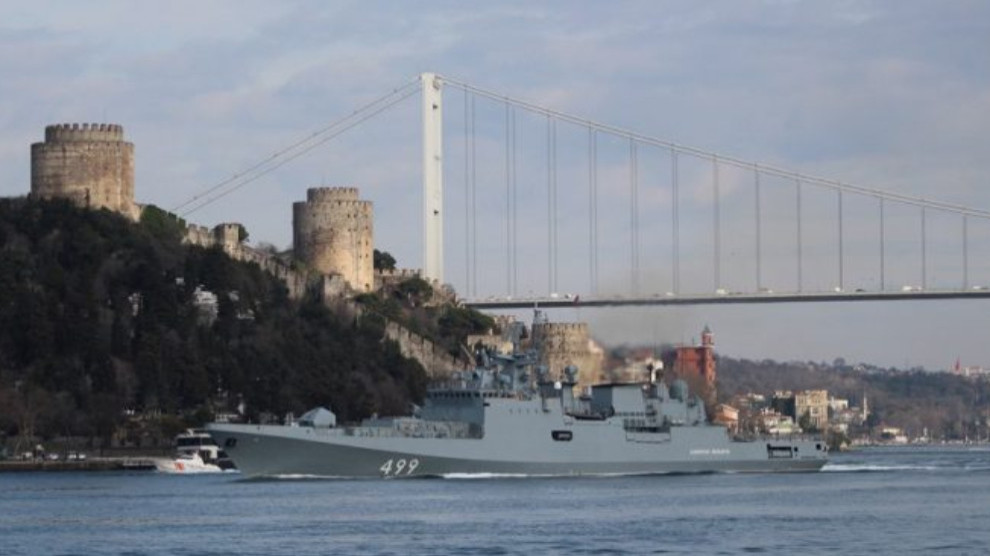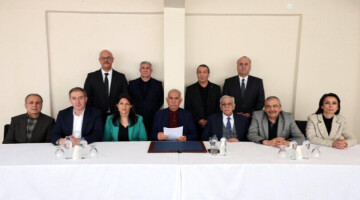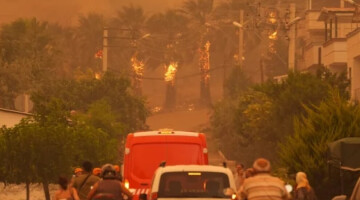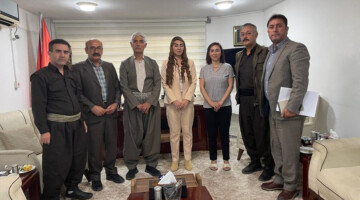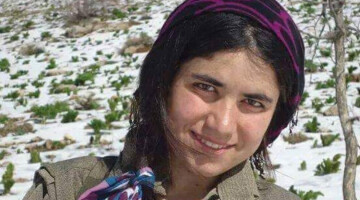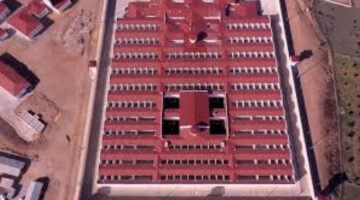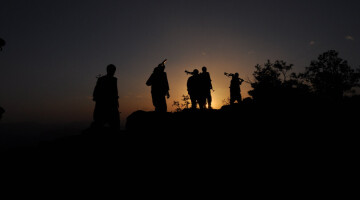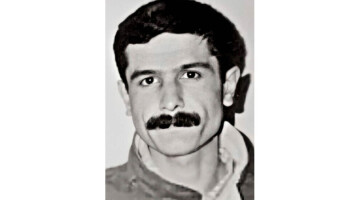The events of the last two weeks in Idlib represent one of the biggest upheavals in the developments taking place in Syria since 2011: The transition from indirect to direct warfare.
The term "proxy war", which has been in circulation since the beginning of the Syrian war, is now no longer used by anyone. So if it is not a proxy war, what else should this war be called? It is still too early to speak of a war between states.
The Syrian army is advancing
The Syrian army has set itself in motion to implement the first stages of the Sochi Agreement of 17 September 2018 with Russian and Iranian support: clearing a 15-20 kilometer wide strip of land in the south and east of Idlib from the armed groups and taking the M5 highway between Aleppo and Damascus and the M4 between Aleppo and Latakia.
Despite Turkey's objections, the Syrian army with its supporters first took Maarat al-Numan and Saraqib and then the west of Aleppo and gained control of the M5. Of the twelve observation posts that the Turkish army set up in the region in accordance with the Sochi Agreement, ten were thus surrounded.
The deadline set by Erdogan
Turkish President Tayyip Erdogan has ordered a massive transfer of troops to Idlib and has given the Syrian forces a deadline of the end of February to withdraw from Turkish observation posts.
The end of the deadline was approaching, but the Syrian forces and their supporters did not withdraw but, after the M5, turned to the M4 and took further areas south of Idlib.
Erdogan's Sochi and Putin's Sochi
During this period, tensions between Turkey and Russia continued to rise. Russia accused Turkey of not meeting the conditions of the Sochi Agreement. The Turkish side, in turn, declared its presence in Idlib in line with this very agreement.
Obviously, the Sochi that Erdogan had in mind was different from the one in Putin's mind. Putin hoped that the agreement would bring the entire Syrian territory back under the regime's control bit by bit. Erdogan, on the other hand, assumed that Idlib would be granted a status with the Sochi agreement.
February is over, the Turkish army attacks
Meanwhile, February was coming to an end, but no one withdrew. Erdogan was even lucky, because February had 29 days this year. But that was not enough. The Turkish army left the observation posts in the south of Idlib with the armed groups on February 27 and took action against the Syrian army.
As a result, Syrian jets took off at the same time and in coordination with Russian fighter jets and the Turkish soldiers who had gone out for the operation were attacked. According to official figures, 36 soldiers of the Turkish army were killed; while local sources speak of over 100 dead.
Was it Russia or Syria?
There is, however, a question; were the Turkish soldiers bombed by Syrian or Russian planes? All the signs point to Russia.
According to available information, the Syrian fighter jets took off first. When they reached the Russian airbase Khmeimim near Latakia, the Russian planes also took off. At that moment the Syrian planes turned away and the Russian jets bombed the Turkish troops.
Turkish authorities, however, insisted on claiming that they had been bombed by Syria. It was, of course, not easy to talk about a Russian attack either, especially as NATO and the US did not signal sufficient support beyond verbal assurances.
Turkey's second offensive: NATO and refugees
After the devastating attack on its soldiers, the Turkish state undertook two offensives: firstly, it pressed the emergency button at NATO and the US, and secondly, it played the "refugee card" that was always kept ready to put pressure on the West.
These are sufficiently well-known facts. What is more confusing, however, is that one day after the attack on the Turkish soldiers, Russia partially opened the airspace over Idlib to Turkish drones. Russia has not allowed the Turkish army to transport their bodies by helicopter. So why were Turkish unmanned aerial vehicles and combat drones allowed one day later?
Pro-Iranian groups were particularly hit
In order to understand this, the places and forces attacked by the Turkish Air Force give certain clues. A large part of them were members of the pro-Iranian Zainabiyoun and Fatemiyoun brigades, the Lebanese Hezbollah and pro-Iranian forces of Mahir al-Assad within the Syrian army.
Of the dead, 14 belonged to Hezbollah and 26 to the Afghan Fatemiyoun militia and the Pakistani Zainabiyoun brigade. One of the dead was Major General Burhan Rahmun, commander of the 124th banner of the Republican Guards commanded by Bashar al-Assad's brother Mahir al-Assad.
Why did Russia open its airspace?
So why did Russia open its airspace? There are various interpretations of this question, but the most important is the conviction that the Russian multi-purpose plan made it necessary.
According to one of the interpretations, Russia has opened up airspace to the Turkish air force in order to soften Turkey's reaction and to avoid NATO and US intervention.
The second interpretation is more confused: it is no secret that a tug-of-war between Russia and Iran has been going on in Syria for a long time. After the Jerusalem Agreement concluded on 25 June 2019 between the US, Russia and Israel, this tension has reached a new level.
Conflict between Russia and Iran
Russia has asserted its weight in the Syrian military, bureaucracy and secret service and hampered many people known for their proximity to Iran.
Israeli air attacks on pro-Iranian forces in the Damascus area have become routine and air defence systems to counter these are not used. On the night of the Turkish attacks, Israel carried out air strikes against pro-Iranian forces in Damascus countryside.
Although the conflict between Russia and Iran has not yet reached a serious level, their differences are obvious. Since Russia knows that Iran is on the radar screen of the international powers, it would not be unreasonable to take the offensive against Iran from time to time in order to establish a policy of balance with the US.
Russia’s multiplayer plan
In fact, Syria is a multi-pitch field for Russia, where it can keep many different forces on a leash. Russia is well aware of both the weaknesses and the strengths of the forces on the ground and moves accordingly. In doing so, Russia does not refuse any tactics that serve its strategy. Ultimately, Russia, as the dominant element in Syria, wants to gain power over the Mediterranean. This includes support for General Haftar in Libya.
Russian frigates crossing the Bosporus
There is another anecdote about the Mediterranean. After the deadly attack on the Turkish soldiers in Idlib, two Russian warships transitted the Bosporus in Istanbul and sailed into the Mediterranean. The names of the frigates were Admiral Grigorovich and Admiral Makarov.
Erdogan's coalition partner Devlet Bahçeli said the following at the faction meeting of his party MHP two weeks ago: "No one should tell us lie stories. We have known Russia since the Battle of '93 [Ottoman-Russian War 1877-1878]. We know whom to shake hands with and to whom to punch." If one remembers these words, the names of the Russian warships seem even more significant.
Under the command of Stepan Osipovich Makarov, the Ottoman fleet was dealt a severe blow in the war mentioned by Bahçeli. Ivan Grigorovich was the last Navy Minister in Tsarist Russia and, at the beginning of the First World War, the first commander to hit the Ottomans in the Black Sea.
In view of the fighting in Idlib and Turkey's distress call to NATO and the US, the message given by Putin who is described in the Arab media as the "new Tsar", to the "new Sultan" Erdogan, is all too obvious.

